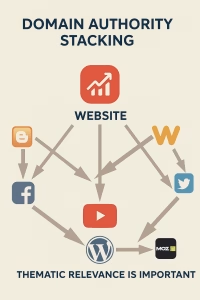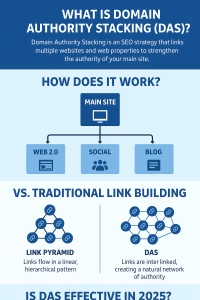Does DAS Still Work in 2025?
Updated for 2025 — The Truth About Domain Authority Stacking, Link Building, and Modern SEO Strategies
Domain Authority Stacking (DAS) is an advanced SEO link-building strategy originally coined by Jimmy Kelly, an SEO expert known for exploring ways to strengthen website authority.
In simple terms, DAS involves interlinking multiple websites, Web 2.0 properties, and social profiles in a strategic way to pass “domain authority” and link equity back to your main website (often called your money site or cash site).
The idea is to build a network of trusted sites that reinforce each other’s authority, eventually boosting the ranking potential of your primary website in Google’s search results.
At its core, Domain Authority Stacking connects several “tiers” of websites together:
- Tier 1: Your main money site.
- Tier 2: High-authority Web 2.0 sites (like Medium, WordPress.com, or Blogger) linking to your main site.
- Tier 3: Social profiles, niche forums, and secondary blogs linking to Tier 2 sites.
Unlike old-fashioned link pyramids, DAS does not follow a rigid structure. Instead, links flow naturally in multiple directions, mimicking organic link behavior — something Google’s 2025 algorithm updates now reward more than ever.
This web of interlinked authority helps to:
✅ Strengthen your backlink profile.
✅ Diversify referring domains.
✅ Build topical relevance and trust signals.
Domain Authority Stacking vs. Traditional Link Building
Many older SEO techniques (like tiered link pyramids) used automated tools such as GSA Search Engine Ranker to blast thousands of low-quality backlinks at lower tiers. The traditional link pyramid, which no longer works, would typically look like the diagram below:
While that might have worked a decade ago, Google’s AI-driven spam filters in 2025 (powered by systems like SpamBrain and Link Spam Update 3.0) now detect and devalue such artificial patterns.
Modern DAS focuses on quality over quantity:
- Use contextually relevant backlinks.
- Focus on real platforms and active profiles.
- Avoid spammy automation.
A well-implemented DAS network looks less like a pyramid and more like a mesh of interconnected authority sources — each adding credibility to your site rather than manipulating rankings.
The image below shows a more realistic example of what Domain Authority Stacking would look like:

This is the million-dollar question.
The SEO community remains divided, but here’s what current testing and case studies suggest:
|
Factor |
Effect on SEO (2025) |
Comments |
|
Improves link diversity |
✅ Positive |
Helps create a natural backlink profile. |
|
Increases DA/PA metrics (Moz, Ahrefs) |
✅ Often |
Useful as supporting metrics, but not ranking factors. |
|
Direct ranking improvements |
⚠️ Variable |
Works best when paired with high-quality content. |
|
Risk of penalty |
🚫 Low (if done right) |
Avoid automation and spammy links. |
Bottom line:
DAS can still move the needle in 2025 when used strategically and ethically — especially in competitive niches or for link velocity balancing.
But it’s not a magic bullet. The biggest ranking factors today remain:
- High-quality, helpful content.
- Topical authority and E-E-A-T (Experience, Expertise, Authoritativeness, Trustworthiness).

One of the simplest and safest ways to build a DAS network today is through automation platforms like IFTTT (If This Then That).
What Is IFTTT?
IFTTT is a free automation tool that connects your social and Web 2.0 accounts together.
For example:
“If I publish a new blog post on my WordPress site, automatically share it on Medium, Tumblr, and Twitter.”
These automated “recipes” (now called Applets) can help you syndicate content naturally across multiple platforms — a white-hat version of DAS that complies with Google’s guidelines.
How IFTTT Supports Domain Authority Stacking
By using IFTTT, you can:
- Automatically post your latest blog updates to 8–12 Web 2.0 and social sites.
- Include canonical tags or noindex attributes to prevent duplicate content issues.
- Build consistent contextual backlinks to your main site.
- Gradually boost your domain authority and brand mentions.
💡 Pro Tip: Use IFTTT alongside trusted platforms like Buffer or Zapier for even broader syndication coverage.
Best Practices for DAS in 2025
To ensure your Domain Authority Stacking strategy is effective — and future-proof — follow these 2025 best practices:
- Start with Quality Content: No stacking will save a weak page. Publish genuinely useful, original content first.
- Use Branded and Naked URLs: Over-optimized anchor text is risky.
- Build Trust First: Strengthen your Web 2.0s and social profiles with unique bios, images, and some posts before linking out.
- Drip Feed Links: Don’t create all stacks at once. Spread link creation over weeks to simulate natural growth.
- Mix Authority and Relevance: Combine high DA platforms with niche-relevant blogs and forums.
Track Results: Use Google Search Console and tools like Ahrefs or Moz to monitor impact on impressions and rankings.
Is Domain Authority Stacking Worth It?
If you’re just starting out, DAS shouldn’t be your first SEO strategy.
Focus first on:
- Solid on-page SEO.
- Internal linking.
- Local SEO and content optimization.
However, if you’re stuck in a competitive niche or need a boost after traditional methods plateau, Domain Authority Stacking can still be valuable — especially when combined with digital PR, guest posting, and content syndication.
Final Thoughts: The 2025 Verdict
Domain Authority Stacking is not dead — it’s evolved.
When used strategically and built on a foundation of authentic content and trusted properties, DAS can:
- Strengthen your backlink ecosystem.
- Improve your authority metrics.
- Support long-term SEO resilience.
But remember: Google now values authenticity and trust more than raw authority metrics.
So, use DAS as a supporting tactic — not your entire SEO strategy.

